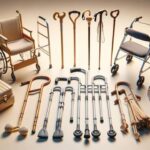Why the Right Walking Aid Is Life-Changing
Mobility challenges can impact nearly every aspect of daily life, from getting out of bed in the morning to staying socially engaged. For seniors, the transition to using a walking aid can feel like a major step—but it’s often a life-changing one for the better. The right device supports balance, reduces the risk of falls, and allows individuals to maintain their routines with confidence. Choosing the right support can help seniors rediscover freedom in their movements, regain confidence, and participate more fully in their communities. This shift is not just physical—it’s emotional and psychological too. A suitable walking aid empowers users to feel less dependent on others, offering a renewed sense of control and dignity.
Smart walking aids now incorporate technology that enhances safety and usability, such as pressure-sensitive handles, GPS tracking, and fall detection. These innovations not only assist with mobility but also offer peace of mind to both users and their families. In many cases, seniors who once avoided going outdoors or attending events due to fear of falling now find themselves re-engaged in activities they love. Ultimately, the right walking aid can restore not just movement, but a sense of purpose and independence.
Who Needs a Walking Aid
Walking aids are not limited to any one type of user. While commonly associated with aging, they are also essential for individuals recovering from surgery, managing chronic conditions like arthritis or Parkinson’s, or those with balance and coordination issues. Recognizing the need for a walking aid is an important step toward improving quality of life. Here are a few signs that someone might benefit from using one:
- Frequent tripping or falling
- Difficulty standing for long periods
- Fatigue or pain while walking
- Loss of balance or coordination
- Fear of walking without assistance
Understanding who needs a walking aid is crucial in ensuring timely intervention. Early use can prevent more serious injuries and make daily activities safer and more enjoyable. By acknowledging the need, individuals can take proactive steps toward maintaining their independence and staying active for longer.
Types of Walking Aids
There are several types of walking aids, each designed to meet specific needs and lifestyles. Understanding the differences can help users make informed choices. The most common types include:
- Canes: Useful for individuals with minor balance issues or slight weakness in one leg.
- Crutches: Often used during recovery from injury or surgery, providing support for those unable to bear weight on one leg.
- Walkers: Provide more stability and are ideal for those who need significant support. They come in various styles, such as standard, wheeled, and rollators.
- Rollators: A type of walker with wheels, brakes, and often a seat. These are excellent for outdoor use and for those who need to rest frequently.
Choosing the appropriate device depends on factors such as the user’s level of mobility, environment, and overall health. Consulting with a healthcare provider or physical therapist can help in determining the most suitable walking aid for an individual’s unique needs.
Top Benefits of Using a Modern Walking Aid
Today’s walking aids offer more than just physical support—they’re designed to enhance the overall quality of life. Modern designs prioritize comfort, functionality, and even aesthetics, making them more appealing and easier to use. Some of the top benefits of using a modern walking aid include:
- Improved balance and stability
- Reduced risk of falls and related injuries
- Increased confidence in daily activities
- Greater independence and social engagement
- Enhanced safety features in smart devices
Smart walking aids take it a step further by integrating features like motion sensors, emergency alert buttons, and health tracking capabilities. These tools help users and caregivers monitor activity levels and respond quickly in case of emergencies. When combined with professional advice and proper training, these devices can significantly improve both safety and lifestyle.
Real Stories: How Walking Aids Restored Lives
Many seniors have shared inspiring stories about how walking aids have transformed their lives. For instance, one individual recovering from hip surgery found that using a rollator enabled her to walk around her neighborhood again, reconnecting with neighbors and regaining her sense of community. Another senior with early-stage Parkinson’s reported that a smart cane with built-in stabilization features allowed him to continue attending his weekly book club without assistance.
These real stories exemplify the emotional and social value of mobility. Beyond physical movement, walking aids help individuals reclaim experiences that matter—spending time with grandchildren, gardening, or simply running errands independently. Family members often notice a boost in mood and self-esteem once their loved one begins using the appropriate aid. These testimonials emphasize that mobility challenges do not have to limit life. Instead, they open the door to new possibilities when addressed with the right tools.
Whether the goal is to stay active, recover from injury, or maintain independence, the right walking aid plays a pivotal role in restoring confidence and quality of life.
How to Choose the Right Walking Aid for Your Lifestyle
Selecting the most suitable walking aid involves more than picking one off the shelf. It requires careful consideration of lifestyle, mobility level, and personal preferences. Here are some tips on how to choose the right walking aid for your lifestyle:
- Assess Your Needs: Determine whether you need support for balance, weight-bearing, or fatigue reduction.
- Consider Your Environment: Will you use the aid indoors, outdoors, or both? Compact models may be better suited for tight spaces, while rollators are ideal for uneven terrain.
- Evaluate Features: Look for ergonomic handles, brakes, foldability, and additional features like seats or storage compartments.
- Seek Professional Guidance: A physical therapist can provide personalized recommendations and training on proper use.
Taking the time to choose the right device ensures better comfort and effectiveness. Matching the walking aid to your daily routine and physical condition makes a noticeable difference in usability and satisfaction. The right choice promotes independence, safety, and a more active lifestyle.
Conclusion: Supporting Independence Through Smart Choices
Walking aids are more than mobility tools—they are instruments of independence, confidence, and connection. Whether you’re navigating a temporary recovery or adapting to long-term mobility changes, finding the right support can make all the difference. Embracing a modern, well-suited walking aid not only enhances physical safety but also contributes to emotional well-being. As technology continues to evolve, these tools are becoming increasingly supportive, discreet, and empowering. Rediscovering freedom is possible at any age, and it often begins with taking that first stable, supported step.









